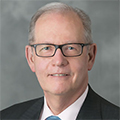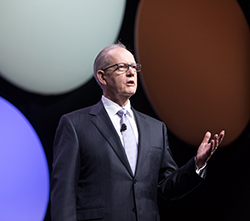Dear Colleagues,
 About one in every twenty thousand Americans is an ophthalmologist.
About one in every twenty thousand Americans is an ophthalmologist.
This fact conveys both a remarkable privilege and a responsibility. We receive the trust of the other 19,999 to preserve their best possible vision. We are responsible to provide the best possible care and advocate for our patients’ needs. And it is up to the Academy to support and enhance those activities.
Bill Rich’s letter and the following articles delineate many of the Academy initiatives related to education, advocacy and quality eye care which address that responsibility.
I’d like to emphasize a few things:
First, while representing only about 2.5% of American physicians, our Academy undertakes a unique leadership role on innovative issues. Take the ONE Network, for example. About ten years ago, driven by then-CEO Dunbar Hoskins and with the full support of the Board of Trustees and staff, the Academy led an effort to build what was then the most ambitious and forward-thinking web presence of any specialty in medicine. The result today is not simply a ‘virtual library of ophthalmology’ but one which increasingly uses new simulation technologies (thanks to a grant from Academy member Stan Truhlsen and his wife, Dottie), personalized learning systems, and about 15,000 pages of content with nearly 1,500 embedded videos. Subspecialty ‘centers’ in glaucoma, ophthalmic pathology, oculoplastics and pediatric ophthalmology have been developed or are under development to focus content. Most significant, the ONE Network is now used by nearly half the ophthalmologists on the planet as a vital part of their education and as a patient-specific care resource. We receive many letters from the U.S. and abroad that basically say, “The ONE Network changed the way I managed this patient.”
The IRIS Registry in a little over three years has grown to be the biggest specialty-specific clinical data registry in the world. About 90% of American ophthalmologists use it—for quality improvement, generating new scientific knowledge and complying with physician payment requirements. The millions of dollars invested in IRIS are yielding hundreds of millions of dollars in avoided penalties and successful bonus submissions by thousands of our colleagues. A big investment, but a much bigger return for our members. Ophthalmology leads the way in big data.

We are also not reticent to take positions on subjects important to our profession. Each of those positions are developed transparently—based generally on the input of hundreds of members—and keeping the patient at the center of the decision. Whether they are positions having to do with federal advocacy, genetic testing, new patient-facing technology or compounded medications, we do so primarily guided by principles—not economics.
None of this would be possible without the leadership and support of the nearly 900 Academy members—from all over the globe—who serve on editorial boards, committees, and task forces. This is supported by a professional culture of engagement in the activities of the profession—something that is not universal in medical societies. This is why members support the Foundation—our charitable and innovation fund. It’s why hundreds come to the Mid-Year Forum each year—to learn about health policy and socioeconomics and to advocate on Capitol Hill. It’s why more than 30 million unique patients are enrolled in the IRIS Registry—because we all went to medical school to be the best and we’ll embrace tools that help us stay that way.
In 2016, Bill Rich was the perfect president for the times—a long and distinguished history of organizational leadership, a keen understanding of health policy and the economics of practice, a champion for quality of care initiatives, and a passion for individual patient care. He led a Board of Trustees balanced by geography, academia versus private practice and comprehensive versus subspecialty. While it could benefit from even more diversity, it has made great strides. Many times I’ve wished that each Academy member could spend some time in the Board room and fully understand the complexity of the issues, the talents in the room and the gravitas of the discussion and decision-making process.
There is no question that 2017 will pose its own set of challenges and opportunities. Hopefully, it will be a time to simplify the regulations that impose an unreasonable burden without improving care. Hopefully, it will be a time of unparalleled scientific discoveries and new technologies that benefit patients. Regardless, we will do our best to advance the profession, serve its members and their patients, and represent the principles that guide us all.
Thank you.
David W. Parke II, MD
Chief Executive Officer
American Academy of Ophthalmology